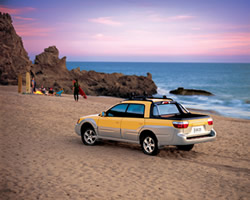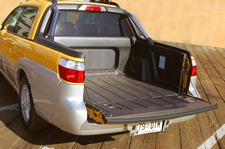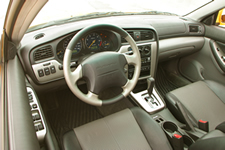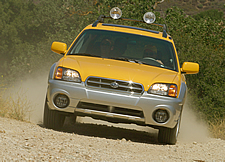|
Looking
Back to See the Future
Subaru's New Baja is
the Right Vehicle at the Right Time
by BJ
Killeen
 Sometimes
in the automotive world, it isn't about having the right vehicle;
it's about having the right vehicle at the right time. For example,
when Nissan introduced the Axxess and Mitsubishi the Expo in
the early '90s, people weren't sure what to make of them. These
vehicles were a cross between a station wagon and a minivan,
but featured four hinged doors and sat higher than a car but
lower than a minivan or SUV. Few people warmed up to them, and
they came and went without much fanfare. Today, those two models
would fit right in with the Toyota Matrix, Pontiac Vibe, and
a slew of new vehicles about to appear on the market, such as
the Chrysler Pacifica. Nissan and Mitsubishi were just out of
sync; the products were good, the timing was bad. Sometimes
in the automotive world, it isn't about having the right vehicle;
it's about having the right vehicle at the right time. For example,
when Nissan introduced the Axxess and Mitsubishi the Expo in
the early '90s, people weren't sure what to make of them. These
vehicles were a cross between a station wagon and a minivan,
but featured four hinged doors and sat higher than a car but
lower than a minivan or SUV. Few people warmed up to them, and
they came and went without much fanfare. Today, those two models
would fit right in with the Toyota Matrix, Pontiac Vibe, and
a slew of new vehicles about to appear on the market, such as
the Chrysler Pacifica. Nissan and Mitsubishi were just out of
sync; the products were good, the timing was bad.
Subaru
is another car company that fell into that scenario. Always
regarded as kind of a "quirky" manufacturer, Subaru's
foray into the unknown was the "Brat," introduced
in 1977. The Brat was what Subaru
called its Bi-drive Recreational All-terrain Transporter, for
lack of a better description. Car and Driver magazine called
it a "truckette." The Brat was an inside-the-cabin
two-seater with two reverse-facing seats outside in the bed
area. It was designed for the youth market and offered four-wheel
drive (before Subaru became a strictly AWD manufacturer), 71
horsepower, and cute-as-a-button styling. But many folks had
trouble overcoming the "what is it exactly?" factor.
After a 10-year run, the Brat sold a total of 92,445 units and
finally was cancelled.
Today,
anything goes, and the more innovative, the better. People are
looking for unique products that offer go anywhere, do anything
versatility, with the convenience of many doors and many seats/seating
configurations. We're not quite at the "transformers"
stage yet, but we're halfway there with the advent of Chevrolet's
full-size Avalanche truck and now Subaru's new Baja.
Described
by Subaru as "a new type of crossover vehicle that blends
the versatility of a compact four-door pickup with the driving
dynamics and comfort of a passenger car," the Baja is the
Brat reincarnated but with more thought-out practicality and
versatility. And it's here at the right time.
While
the Chevy Avalanche can be credited with the first production
version of the "passenger vehicle to truck cargo"
reconfiguration scheme, Subaru goes it one better by offering
the smooth ride of a passenger car. The Baja is based on the Legacy platform, and shares
its 104.3-inch wheelbase with the Legacy Outback wagon. The
biggest difference, though, is that the Baja offers about six
inches more rear overhang. And while the front clip is basically
Outback, specific Baja modifications include a different grille,
front and rear bumpers, side cladding and a stylized fuel door.
The overall design is based on the ST-X concept truck first
shown to the public at the Los Angeles Auto Show a few years
ago, long before anyone had heard of the Avalanche.
The
Baja, thanks to its size, is more user friendly than the Avalanche,
since average height people can actually reach inside the bed
instead of needing a stepladder to do any cargo loading/unloading.
And also because it's smaller, the "Switchback" system
is easier to reach and manipulate.
The Baja looks substantial, with a two-tone paint/cladding exterior
finish, chrome structural sport bars that dress up the bed area,
and an integrated, molded-in plastic liner with grip surfaces
on the floor and sides. There are two holes with screens in the
cargo floor that pass the water through, routed
to the rear of the vehicle to allow for easy rinse out and draining
away from the cab area.
The bed also features four tie-down hooks and two-tier storage. The lower cladding- Silver Stone color with integrated splash guards-helps protect the Baja from rocks and debris it may encounter on off-road excursions. While the Baja is all-wheel drive and can go off-road with its 7.3 inches of ground clearance, it is not intended for serious rock climbing or mud bogging since it has no four-wheel-drive low mode. But that wasn't Subaru's intentions for the Baja. It was designed to trek on the beach or travel dirt roads to your favorite diving hole or hang-gliding cliff.
 Subaru's expectations for the Baja definitely are to use it for just about any outdoor adventure, including moving washing machines to hauling scuba gear to bringing home lumber and pvc pipe for home improvement products. For those who wish to tow for their adventures, the Baja is rated at 2,400-lb capacity, with an approximately 1,000-pound payload rating. Although for now the only accessory is the cargo bed extender, Subaru assures us there are many more add-ons (such as for skis, kayaks, and snowboards) to come. One of the coolest features of the Baja is the two-position license plate bracket that's designed to swing down and remain visible even when the tailgate is lowered. This was one of the concepts carried over from the ST-X show truck. Finishing the package are 225/60HR16 Bridgestone Potenza tires mounted to standard 16 x 6.5-inch alloy wheels. There is no optional wheel/tire package for the Baja for 2003. Subaru's expectations for the Baja definitely are to use it for just about any outdoor adventure, including moving washing machines to hauling scuba gear to bringing home lumber and pvc pipe for home improvement products. For those who wish to tow for their adventures, the Baja is rated at 2,400-lb capacity, with an approximately 1,000-pound payload rating. Although for now the only accessory is the cargo bed extender, Subaru assures us there are many more add-ons (such as for skis, kayaks, and snowboards) to come. One of the coolest features of the Baja is the two-position license plate bracket that's designed to swing down and remain visible even when the tailgate is lowered. This was one of the concepts carried over from the ST-X show truck. Finishing the package are 225/60HR16 Bridgestone Potenza tires mounted to standard 16 x 6.5-inch alloy wheels. There is no optional wheel/tire package for the Baja for 2003.
Although there is no true direct competition for the Baja, the closest Subaru could come up with is the Ford Explorer Sport Trac or the late El Camino pickup. Subaru even tossed the Toyota Tacoma into the mix for an import competitor.
Inside, the Baja offers plenty of utility, with seating for four full-size adults and captain's chairs at all positions. As much attention was paid to the comfort of the rear-seat passengers as there was to those in front. There's tinted glass on the rear doors and rear window for reduced solar rays, a center console/armrest, and a rear console box in the seat bottom for the two integrated cupholders. Leather seats are the only fabric choice, with perforated inserts for breathability and the Baja logo embroidered on the seatback. Subaru decided to forego the cloth interior, they felt the leather would hold up better over time.
 The interior is sporty, with a mix of silver metallic finish trim pieces to complement the black and silver leather-wrapped steering wheel and shift handle. The silver metallic trim also surrounds the instruments and door switch bezels. Subaru's goal was to make the Baja remind you more of a car than a truck, and this is a good way to achieve that goal. The interior also is full of standard features that are usually options on other vehicles. Some of these include: air conditioning, six-way power driver's seat, cruise control, keyless entry, power moonroof, power windows/locks/mirrors, and an 80-watt AM/FM/CD audio system. The interior is sporty, with a mix of silver metallic finish trim pieces to complement the black and silver leather-wrapped steering wheel and shift handle. The silver metallic trim also surrounds the instruments and door switch bezels. Subaru's goal was to make the Baja remind you more of a car than a truck, and this is a good way to achieve that goal. The interior also is full of standard features that are usually options on other vehicles. Some of these include: air conditioning, six-way power driver's seat, cruise control, keyless entry, power moonroof, power windows/locks/mirrors, and an 80-watt AM/FM/CD audio system.
The Baja is most versatile due to the Switchback system, which provides added cargo room in seconds. To switch from a four-passenger to a two-seater with extra bed room and length, just fold up the rear seat cushions and fold down the rear seatback. On the back of both cushions is the same anti-slip material featured on the bed liner. Unlike the Avalanche, the Baja's back window is not removable, but it adds to the Baja's overall structural integrity.
While Subaru vehicles usually come well equipped, what Subaru is known for first is all-wheel drive. The Baja is the embodiment of Subaru's AWD system. It works transparently and with no driver input, providing control in inclement weather and in low-traction situations. The continuous system, in vehicles equipped with the 5-speed manual transmission, uses a viscous-coupling in the center differential mounted inside the transaxle case. In normal operation, power is equally distributed 50/50 front and rear. When the system senses slippage, the system transfers the torque where it's needed most, and then returns to 50/50 once the slipping ceases.
In automatic tranny cars, the Active AWD uses an electronically monitored continuously variable transfer clutch housed in the transaxle tailshaft. This system adjusts the power split instantly, depending on a variety of factors. When slip occurs in front, hydraulic pressure on the transfer clutch is increased to help transfer power to the rear; when the front regains traction, the pressure on the clutch is reduced, transferring power back to the front wheels. In addition to AWD, the Baja comes standard with a limited-slip rear differential, to help transfer the torque side to side. Every Subaru model comes with AWD for added driver confidence.
Another Subaru trademark is the use of horizontally opposed engines. The 2003 Baja also has one, and it's the 2.5-liter SOHC four-cylinder powerplant that produces 165 horsepower and 166 lb-ft of torque. The good news for those watching their pennies is that the Baja runs on regular unleaded gasoline and gets 20 mph in the city and 25 on the highway for the 5-speed manual transmission. In keeping with the car-like ride, the suspension on the Baja is independent at all four corners. Up front are MacPherson-type struts with internal rebound springs and improved shock valve tuning for good ride compliance and lateral rigidity, as well as noticeable reductions in dive and squat under braking and acceleration. In back, the Baja features a multi-link setup mounted to a rubber-isolated subframe to help with reductions in noise, vibration, and harshness. In addition, the rear also features coil springs, shocks, and a stabilizer bar.
Safety has always been important to Subaru, and it backs up its commitment with standard four-channel, four-sensor anti-lock brakes on four-wheel discs with dual-piston calipers up front for added braking performance. All four seating positions feature three-point harnesses, and there are dual-stage airbags for the driver and front-seat passenger. Daytime Running Lights (DRLs), the LATCH child seat restraint system, and headrests at all positions also enhance the Baja's desirability.
 We had a chance to spend a few hours in the new Baja, and spent a pleasant day scouting for photo locations up the coast. We were thrilled with the ride comfort in the Baja; the suspension did an excellent job of soaking up bumps and rough patches of asphalt. Because it looks like a truck, it's understandable to think it would ride like one, but it really feels like you're in the plush Outback wagon. We thought the interior was well laid out and intuitive, but felt a bit cramped with just the driver and front seat passenger. There was, however, plenty of room for our camera gear, bags, towels, and other beach paraphernalia. Our Baja came with the bed extender, but we didn't have anything on this trip long enough to test it. The rear seats folded easily, and the extra room would be appreciated for taking the bikes up to the mountains or just to the local bike path at the Venice beach boardwalk. We had a chance to spend a few hours in the new Baja, and spent a pleasant day scouting for photo locations up the coast. We were thrilled with the ride comfort in the Baja; the suspension did an excellent job of soaking up bumps and rough patches of asphalt. Because it looks like a truck, it's understandable to think it would ride like one, but it really feels like you're in the plush Outback wagon. We thought the interior was well laid out and intuitive, but felt a bit cramped with just the driver and front seat passenger. There was, however, plenty of room for our camera gear, bags, towels, and other beach paraphernalia. Our Baja came with the bed extender, but we didn't have anything on this trip long enough to test it. The rear seats folded easily, and the extra room would be appreciated for taking the bikes up to the mountains or just to the local bike path at the Venice beach boardwalk.
While the 165-horsepower engine was adequate for the Baja, all the journalists kept talking about was how much better it would be with the more powerful flat six engine from the Outback H6 3.0 wagon of 212 horsepower and 210 lb-ft of torque. Our test vehicle also came with the five-speed manual transmission that was within easy reach, and it felt solid with no slop when shifting up or down. We'd also like to see a bigger wheel/tire package as an option, too.
Although prices haven't been released, estimates for the Baja place the cost in the mid $20,000 range. The Baja goes on sale September 1 as a 2003 model, and Subaru expects to sell about 2,000 units a month for the first model year. Since it's built on the same lines as the Legacy and Outback, production could be adjusted upward depending on demand.
|